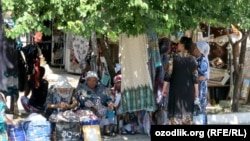
RFE/RL's Uzbek Service, known locally as Ozodlik, has been receiving some curious information from Uzbekistan's section of the Ferghana Valley, where it appears the authorities are implementing some new policies at the bazaars and in the mosques.
As has been unfortunately true for some time in Uzbekistan, it is difficult to verify information about what is happening inside the country. The Uzbek government would rather not endure international criticism for its actions, so Uzbek authorities work hard to prevent uncensored information about the country from getting out.
Those who do speak to Ozodlik, for example, prefer not to be named for fear of government reprisals.
At the end of April, Ozodlik reported on the new "hudjum" campaign in Kokand and Margilan, where security officers in civilian clothes were patrolling bazaars and forcing women to remove head scarves.
Ozodlik has discovered a new dress code is in effect at some bazaars in Kokand and Margilan. Local authorities have placed signs at the gates of the bazaars warning women not to wear "Arab-, Iranian-, Turkish-, or Pakistani-style" hijabs while at the bazaar.
It is not only women who have been affected by the authorities' new fixation with headwear. Men are forbidden from wearing a white "doppi," the traditional skullcap of Uzbeks and Tajiks. Usually such caps are more black than white and these are permitted, though it should be mentioned that nearly all the Uzbek and Tajik men of Central Asia wear the black doppi, so it would be nearly impossible, and certainly unpopular to ban.
More recently, some worshippers have told Ozodlik that the authorities have ordered the removal of banners with sayings from the Koran from the walls of more than 20 mosques in Namangan.
One person in Margilan said banners with phrases such as "a prayer said with a turban on is more important than 70 prayers said without any head covering" and "return my heart to prayer" were removed at the mosque he attends.
This person and another worshipper from Margilan also claimed the electronic prayer timetable that shows when daily prayers start has been turned off at some mosques in Margilan.
A cleric at one mosque confirmed the electronic timetables had been switched off and banners with Koranic verses were taken down after a special commission arrived from Tashkent, the capital, and gave such instructions.
One of these sources said the imam-khatib of Ferghana Province had ordered this done. Ozodlik contacted the imam-khatib, Tursuntohir Erbutaev, to ask about this information. Erbutaev responded curtly, saying only: "Nothing is being taken down in the mosques. Whoever said this, it's a lie."
On May 24, the imam of the Honaqoh Mosque, Ubaydulla Abdullaev, responded directly to Ozodlik's story through the state Internet news site 12news.uz, saying, "Believers are very pleased with the state of and conditions created in the mosques in Ferghana Province." He added, "Instigators, using the media, seek to sow discord among the people and destroy the peaceful life of society."
Residents of Margilan told Ozodlik some mosques in Ferghana Province had not been subjected to these actions by the authorities, so it's difficult to understand the reasons for taking such steps.
The cleric who said the electronic prayer timetables had been turned off also said he thought the measures were prompted by fears of the Islamic State militant group, but he could not explain the connection.
The deputy chairman of Uzbekistan's Department for Religious Affairs, Sheykh Abdulaziz Mansur, spoke with Ozodlik about the alleged situation in the mosques in Margilan. Mansur promised in mid-May to look into the claims and get back to Ozodlik. Ozodlik contacted Mansur on May 26 and he said he was still investigating the stories.
-- Bruce Pannier, with contributions from Farruh Yusupov and Shukhrat Babajanov of Ozodlik






